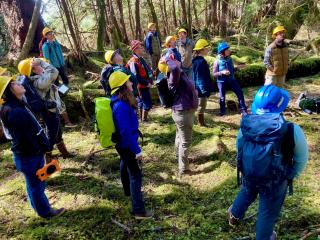Modernizing hazard tree assessments in Alaska

ALASKA—The word hazard can conjure up images of bright orange warning signals, extreme conditions or imminent danger. This is only sometimes the case when defective trees are involved in a forest setting. In forests, trees are vital features that draw visitors to public-use cabins or developed recreation sites.
To the untrained eye, hazard trees—capable of causing considerable damage or harm to people or structures—can look like other trees and may be large and beautiful. No one, especially those who love the outdoors, wants to remove trees from the forest community without careful consideration. But how can we know which trees pose an unacceptable risk?
Forest Health Protection forest pathologists Robin Mulvey, Dr. Kymi Draeger and Dr. Lori Winton, experts in their field, are using new approaches to train other Forest Service employees to recognize hazard trees. They provide technical assistance, training and tools to ensure Forest Service staff in Alaska have everything they need to conduct systematic assessments.
One of the most practical tools in their arsenal is the ghostbusters-esque micro resistance drill, a tool that uses a minimally invasive approach to determine structural soundness of tree stems. This technology is particularly useful for trees that are pillars of impressive beauty or size and close to cabins and structures that see prolonged visitor use. Micro resistance drills use a long, very thin drill bit to detect internal decay and hollows inside woody stems, providing a graphical depiction of the tree’s inner structure.
Another part of the initiative to make systematic hazard tree assessments more efficient is a customizable survey developed on Survey123 for use across the Alaska Region. This survey and the training help users identify factors that reduce structural integrity.
The Alaska Region Hazard Tree Group, a collective of ArcGIS users, plays a crucial role in technical assistance and data management related to the mobile survey developed by the Alaska Region. While the rating system used in the mobile survey isn’t new, it represents a significant step forward in hazard tree assessments. Survey users are capable of tracking hazard tree work, locations, changes and mitigation efforts, making the process more efficient and effective.
This spring, Dr. Draeger and Mulvey imparted their knowledge of hazard trees to groups of enthusiastic Forest Service employees from the Petersburg, Ketchikan, Prince of Wales and Glacier Ranger districts. This type of training is recommended in the spring before heavy visitor use and held at the request of district staff.
With continuously improving tools and methods, these systematic assessments and training allow districts to make unbiased decisions about hazard trees. Contrary to belief, hazard tree mitigation does not always involve removing them. Monitoring may include moving the target or site closure for trees of exceptionally high importance. The desired result is the same—safer recreation sites for everyone.



